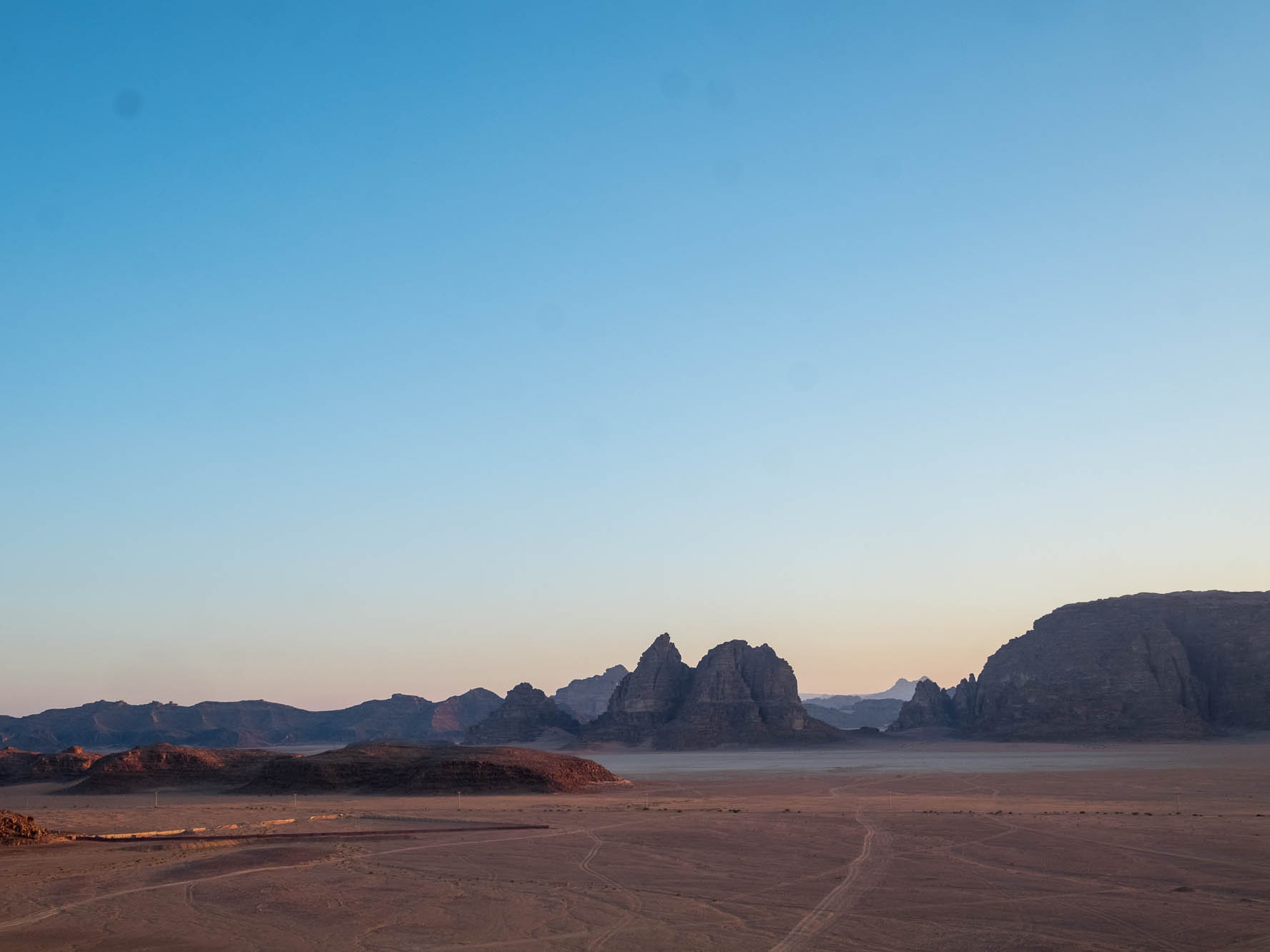- Wadi Rum, a desert valley in Jordan, has played the part of Mars and distant planets in countless movies, including “The Martian,” “Star Wars: Rogue One,” “Prometheus,” and Red Planet.”
- The reddish hue of the sand combined with the massive granite rock faces and sandstone mesas makes for an otherworldly landscape.
- I recently visited, and it was breathtaking. I’m already planning a return trip so I can spend more time in Wadi Rum.
Don’t tell Elon Musk, but you don’t have to fire off into space to visit Mars. Just get on a plane – or a bus – to the Middle Eastern country of Jordan.
Jordan is a small, dry, mostly landlocked country that neighbors Israel to the east. Within its rugged terrain is Wadi Rum, a desert valley known for its dramatic sandstone and granite rock faces and the reddish hue of its sand.
The landscape is so otherworldly that countless filmmakers have used the desert as a location for films taking place on distant planets.
Most recently, the desert served as the backdrop for Mars in the Matt Damon-starring space-survival film “The Martian.”
But "The Martian" is far from the only film to use the desert. Wadi Rum played the part of Mars in the 2000 film "Red Planet" and the 2013 film "The Last Days on Mars." It played the part of the alien world in the 2012 horror film "Prometheus" and the planet of Jedha in "Rogue One: A Star Wars Story."
On a recent trip to Jordan, I decided to take a road trip through Wadi Rum. After barreling through the desert in jeeps, sprinting down sand dunes, and riding on ATVs, I think I can say I've officially visited another planet.
Here's what it was like:
To start with, on the left is an actual photo of Wadi Rum. On the right is a picture of the same rock formation with some visual effects to make it look a bit more like Mars. But as you can see, it's not a stretch.

Read more about my visit to Petra »
I decided to take a tour through Jordan to visit the desert of Wadi Rum and the ancient archeological site of Petra in two days. After being blown away by Petra, I was skeptical that Wadi Rum could top it.

But when we arrived at the Bedouin camp in Wadi Rum after visiting Petra, I knew I was wrong. While Wadi Rum is mostly uninhabitable, Bedouins have lived in different parts of the desert for centuries. Today, many run luxury campsites for tourists and Jordanians.

Our guide pointed out a cliffside behind the camp that he suggested would be a good viewpoint to see the landscape during the sunset. It was a short, 10-minute hike up.

But the view was stunning. It was immediately apparent why some Jordanians call Wadi Rum "The Valley of the Moon." The landscape certainly looked lunar or Mars-like.

As sunset began to descend, winds picked up the fine sand that blankets the desert. The desert turned to an ethereal purple red. It looked like one of the sandstorms that Matt Damon's character survives in "The Martian."

Overlaid with a light fog (or dust, I couldn't tell), the sunset looked like a watercolor painting. I could have sat up there for hours.

I wasn't the only one. The rock formation was covered with other people in the tour, as well as the Jordanians staying at the camp, enjoying the sunset.

Here's an aerial look at the Bedouin camp where I stayed. In front is the restaurant and bar, followed by a pool and an encampment of tents and "chalets" (don't get excited, they're more like air-conditioned shacks), and an amphitheater for events.

While Wadi Rum has been used for countless sci-fi movies, its first appearance in a film was anything but. It figured prominently in the 1962 classic "Lawrence of Arabia," based on the life of T.E. Lawrence, the British traveler famed for his participation in 1916 Arab Revolt.

The real-life Lawrence spent considerable time in Jordan, particularly in Wadi Rum. He called it "vast, echoing, and God-like." I have to agree.

The following morning I woke up at 5:45 to catch the sunrise. With only a 10-minute walk to the viewing point, I had no excuses to miss it.

It was far less crowded at sunrise. Just a couple of watchers.

In the hour after sunrise, the desert lights up in crimson. It's a dramatic shift that I will not soon forget. For a moment, I forgot I was on earth.

After breakfast, I headed with the tour group for a jeep tour through the desert. It turns out, however, that the definition of "jeep" varies from culture to culture. We were being taken out in rickety old pickup trucks outfitted with benches.

But as soon as we passed onto the sand, all worry was forgotten. As Lawrence wrote, "Our little caravan fell quiet, afraid and ashamed to flaunt its smallness in the presence of the stupendous hills." Well said, old chap.

Despite the age of the trucks, the Bedouin drivers drove at full speed through the sand. They were skilled drivers. There was no slipping and sliding.

The sand in Wadi Rum is known for being the reddest in Jordan. It's colored by iron oxide.

Source: National Geographic
Interestingly, the desert was a pleasant temperature if you weren't in the sun. The structure of the valley creates a consistent breeze. Without this makeshift sun cover, though, I would have been roasted.

There are tons of activities that you can do in Wadi Rum, from riding camels as if you were T.E. Lawrence to hiking, rock climbing, or camping. Some camps even have clear glass bubble tents so you can watch the stars all night.

But I only had a day to explore. Next time, I'd like to camp out in the desert for four or five days. This view was from the top of a rock arch where the guides brought our group.

It's not just the color of the sand but also the craggy structure of the rocks and hills that makes Wadi Rum look like another planet. Many of the mesas are older than the Dead Sea between Jordan and Israel.

Source: National Geographic
National Geographic describes the formations as the "result of primordial tectonic movement that cleaved the bedrock with almost cubic perfection before raising it high above the desert floor."

Source: National Geographic
Don't be fooled by the stray camels. None of them are wild. As our guide, Nizar Alhasani, told the group, the only wild animals left in Jordan are foxes, hyenas, wolves, and smaller animals.

What's perhaps most surprising is that Wadi Rum wasn't always this dry. Both Greeks and Romans have referred to the desert as being known for its vineyards and olive and pine trees.

Source: Lonely Planet
Human existence in Wadi Rum dates back more than 12,000 years. It is one of the migratory routes humans took out of Africa. There are more than 20,000 petroglyphs and inscriptions along the rock formations in Wadi Rum. Unfortunately, there was no time to explore them.

After a bit more driving around we came to this massive mesa. Along the side was a large sand dune with the finest sand I had seen yet.

Alhasani encouraged us to take off our shoes, climb up the sand dune along the rocky ridge, and then sprint down. I made the mistake of listening to his advice. Even the rocky ridge was hot enough to scramble eggs.

The run down the dune was pretty fun, though. I went extra fast because I needed to get my shoes back on. It was hot, hot, hot.

After running down the dune, it was time to drive back to camp. I could have sat in the back of that jeep for hours with the wind rippling by, looking at the vastness of the landscape. But let's be honest: If I were sweating on the back of a camel, throat parched, that vastness is the last thing I'd want to see.

After heading back to camp, I found out we could rent out ATVs for a short tour of another part of the desert. Not feeling as if I'd had my fill, I opted in. Also, driving ATVs is just plain fun.

Even more so when you can gun it at top speed through hard-packed sand.

Our guide took us to this interesting rock formation. All kinds of natural sculptures are spread throughout the desert, shaped by blowing sand and winter floods. You could probably spend months exploring them.

Perhaps surprisingly, Alhasani says Wadi Rum is actually "unbearably cold" in the winter. Temperatures drop below freezing at night, and the wind is very strong.

Unfortunately, we ran out of time. We had to jet back on the ATVs to our tour bus for the long ride back to Israel. Don't tell my Israeli friends, but I think the most fun I had while visiting Israel was in Jordan.


